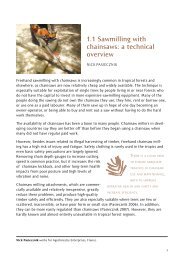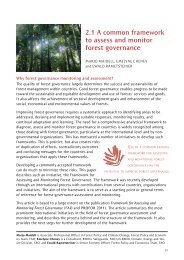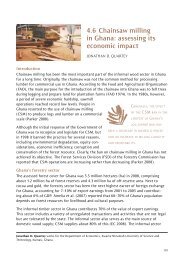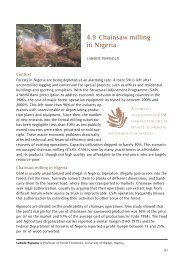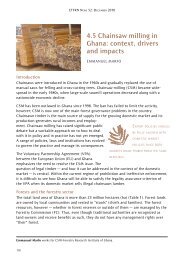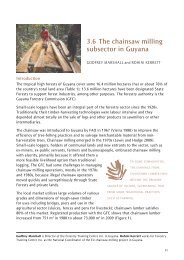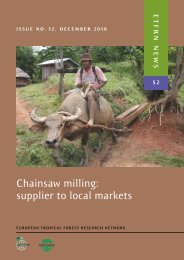Chainsaw milling: supplier to local markets - European Tropical ...
Chainsaw milling: supplier to local markets - European Tropical ...
Chainsaw milling: supplier to local markets - European Tropical ...
You also want an ePaper? Increase the reach of your titles
YUMPU automatically turns print PDFs into web optimized ePapers that Google loves.
2.3 The chainsaw<br />
economy in Tanimbar<br />
archipelago, indonesia<br />
JEAN-MARC RODA, PATRICK LANGBOUR and<br />
BAYUNI SHANTIKO<br />
introduction<br />
The Tanimbar islands are of great interest for their biodiversity (lidon and kartiwa 2005).<br />
located in the province of maluku, indonesia, their main city, saumlaki, is also a district<br />
capital. The islands were extensively studied during<br />
the Tanimbar land-use planning project, funded by<br />
in The absence of<br />
the <strong>European</strong> Commission, which covered land-use<br />
formal resource<br />
planning, biodiversity protection and biodiversity<br />
managemenT, noThing<br />
enhancement through participa<strong>to</strong>ry approaches<br />
(Jewell et al. 2006; astawa et al. 2006).<br />
prevenTs The over-<br />
exploiTaTion of The more profiTable<br />
The project team analyzed the wood production<br />
system in the southern part of Yamdena island species.<br />
(lidon and kartiwa 2005), where chainsaw activities<br />
supply most of the wood <strong>to</strong> <strong>local</strong> villages, saumlaki, other indonesian islands, and<br />
abroad. Two villages of south Yamdena, wermatan and ilngei, specialize in chainsaw<br />
<strong>milling</strong>, although at a very rudimentary level. wermatan is accessible only by sea and has<br />
an economy shaped by its traditional social structure. ilngei, which is very close <strong>to</strong> saumlaki<br />
and connected <strong>to</strong> it by a paved road, has a comparatively advanced state of economic<br />
development that is reflected in its wood production system (shantiko et al. 2004).<br />
wermatan<br />
How tradition shapes the chainsaw economy<br />
The wood activities in wermatan basically consist of community-based chainsaw <strong>milling</strong>.<br />
Trees are felled with chainsaws and processed on site in<strong>to</strong> beams or planks. The process<br />
is not efficient; the recovery rate 1 is less than 5%. a typical work team consists of one<br />
chainsaw opera<strong>to</strong>r and two assistants. usually the chainsaw opera<strong>to</strong>r owns the machine.<br />
sometimes a relative borrows a chainsaw; in that case, the owner and opera<strong>to</strong>r share the<br />
income. a team usually spends a working week 2 in the forest harvesting trees, processing<br />
the timber, and carrying it <strong>to</strong> the river. a team produces about 10 m 3 of sawn timber per<br />
week.<br />
Jean-marc roda works for CiraD, kepong, malaysia; Patrick Langbour works for CiraD, montpellier, France<br />
and bayuni shantiko works for the Center for international Forestry research (CiFor).<br />
31



